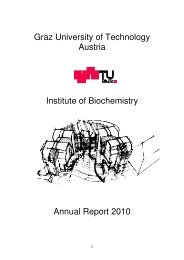Staff Members of the Institute of Biochemistry, TU - Institut für ...
Staff Members of the Institute of Biochemistry, TU - Institut für ...
Staff Members of the Institute of Biochemistry, TU - Institut für ...
Create successful ePaper yourself
Turn your PDF publications into a flip-book with our unique Google optimized e-Paper software.
Molecular Biology Group<br />
Karin A<strong>the</strong>nstaedt<br />
Triacylglycerol syn<strong>the</strong>sis in <strong>the</strong> oleaginous yeast Yarrowia lipolytica<br />
The oleaginous yeast Yarrowia lipolytica has an outstanding capacity to accumulate huge<br />
amounts <strong>of</strong> triacylglycerols (TAG). Along with o<strong>the</strong>r neutral lipids, TAG are stored in socalled<br />
lipid particles. The structure <strong>of</strong> <strong>the</strong>se cell compartments is ra<strong>the</strong>r simple. Mainly TAG<br />
and steryl esters are forming a hydrophobic core which is surrounded by a phospholipid<br />
monolayer with few proteins embedded. By growing Yarrowia lipolytica cells in media<br />
containing, e.g., industrial fats or glycerol as a carbon source, <strong>the</strong> amount <strong>of</strong> TAG can be<br />
increased up to 40% <strong>of</strong> cell dry weight. This ability leads to its application in biotechnological<br />
processes such as single cell oil production or production <strong>of</strong> nutrients enriched in essential<br />
fatty acids which can serve as nutritional complements. However, Yarrowia lipolytica may<br />
also serve as a model organism to study lipid turnover in adipocytes, since not only <strong>the</strong> ability<br />
to store excessive amounts <strong>of</strong> TAG in lipid particles but also <strong>the</strong> composition <strong>of</strong> this cell<br />
compartment resembles adipocytes <strong>of</strong> higher eukaryotes. Despite <strong>the</strong>se potentials <strong>of</strong> Yarrowia<br />
lipolytica information about TAG (lipid) metabolism in this yeast is ra<strong>the</strong>r limited. Thus, we<br />
started to investigate <strong>the</strong> proteome <strong>of</strong> Yarrowia lipolytica for proteins involved in TAG<br />
syn<strong>the</strong>sis. Homology searches with TAG synthases <strong>of</strong> o<strong>the</strong>r eukaryotes as queries highlighted<br />
two candidate gene-products <strong>of</strong> <strong>the</strong> oleaginous yeast potentially catalyzing <strong>the</strong> formation <strong>of</strong><br />
TAG. A decreased amount <strong>of</strong> TAG in mutant cells defective in <strong>the</strong>se candidate genes already<br />
pinpointed to a function <strong>of</strong> <strong>the</strong>se polypeptides in TAG formation. To investigate whe<strong>the</strong>r<br />
<strong>the</strong>se candidate genes encode true TAG synthases <strong>the</strong>se genes were heterologously expressed<br />
in cells <strong>of</strong> a Saccharomyces cerevisiae mutant defective in neutral lipid syn<strong>the</strong>sis and as a<br />
consequence lacking lipid particles (Fig. 1).<br />
A B<br />
C D<br />
Figure 1: Restoration <strong>of</strong> lipid particle formation upon heterologous expression <strong>of</strong> Yarrowia<br />
lipolytica TAG synthase candidates in mutant cells <strong>of</strong> <strong>the</strong> budding yeast Saccharomyces<br />
cerevisiae lacking lipid particles.<br />
In contrast to <strong>the</strong> negative control (B; mutant + empty plasmid), lipid particles are formed in<br />
mutant cells transformed with plasmids bearing ei<strong>the</strong>r <strong>of</strong> <strong>the</strong> respective candidate genes <strong>of</strong><br />
Yarrowia lipolytica (C, D). Panel A shows lipid particle formation in a wild-type cell <strong>of</strong><br />
Saccharomyces cerevisiae. Lipid particles are indicated by arrows. Size bar: 10 µm.<br />
Fluorescent microscopic inspection and lipid analyses <strong>of</strong> <strong>the</strong> respective mutants clearly<br />
demonstrated that <strong>the</strong>se Yarrowia lipolytica genes encode true TAG synthases. The<br />
24














